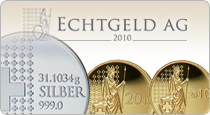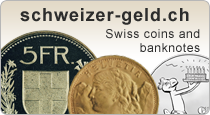
Switzerland and the monetary crisis in Europe
Author: Prof. Antal E. Fekete
Resurrect the Latin Monetary Union!
A firm by the name ECHTGELD AG in Bern, Switzerland, is making gold bars available to the public that reproduce the size, shape and fineness of the 10 and 20 franc pieces used by the Latin Monetary Union (1865-1927). These beautiful bars (2.9032 and 5.8064 grams) are a reminder that Europe once used to have a successful monetary union enabling member countries to pay for imports with their own coins, obviating exchange. Tourists didn’t have to change currency upon crossing borders. Europe had all the advantages that the euro is supposed to offer, and none of the disadvantages. Under the Latin Monetary Union world trade and international tourism reached heights unheard-of previously, setting records that it took more than half a century after World War I to beat. The coins of the Latin Monetary Union made capital flows from one country to another easy without generating centrifugal forces threatening to rip the union apart. Separation of monetary policy from fiscal policy was not a problem. Monetary policy was not politicized. It had just one aim: that of keeping the value of the currency stable. Governments were not allowed to use monetary policy to plug the holes in their balance sheets, as they do it today.
The euro had the laudable aim to recreate the idyllic conditions prevailing before World War I, and the halcyon days of the Latin Monetary Union, of which Switzerland was a founding member. However, the euro was shipwrecked on the reef of the divergent fiscal policies of member countries. Before the euro, monetary policy could be used to plug the holes in the balance sheet of governments. This was no longer possible to do after the euro was introduced as a common currency in the year 2000.
How could the Latin Monetary Union avoid this trap? Well, it had something Euroland does not. It had circulating gold, the ultimate extinguisher of debt. Euroland is not a viable monetary union because its member states are creating debt at different rates. Once debt is created, it stays in the system forever. It is the responsibility of no one. The collectivist principles embraced by individual members extend only to the benefits but not to the countervailing duties. The mentality is that deficit spending is a birthright of sovereign countries, while they deny the existence of ‘sovereign debt’. If debt there is, it is the responsibility of the union.
In the Latin Monetary Union such collectivist principles were unknown and unacceptable. There was meaningful debt retirement. Countries guilty of failing to retire debt on schedule had to face punishment. They were losing gold.
The Latin Monetary Union also had silver coins for smaller payments in denominations of 1, 2 and 5 francs. They were freely exchangeable for gold francs at a constant exchange rate at the mint. It would have been better to call these silver coins ¼, ½ and 1 thaler and allow their value to fluctuate in terms of the gold franc. Ultimately the fixed exchange ratio between gold and silver brought about the downfall of the Latin Monetary Union 1926. The Union was forced to close its mints to silver as a consequence of the rapid decline in the silver price after Germany and the United States demonetized the metal in the early 1870’s. It was forced to close its mints to gold as well when World War I started in 1914.




